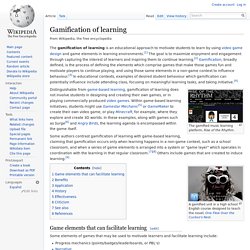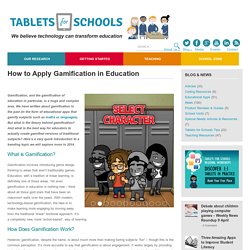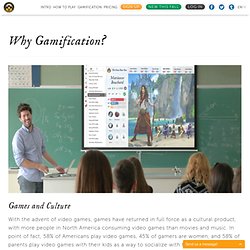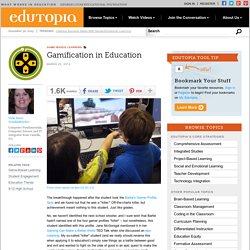

The Gamification of Education Infographic #gamification #edtech. Gamification of learning. The gamification of learning is an educational approach to motivate students to learn by using video game design and game elements in learning environments.[1] The goal is to maximize enjoyment and engagement through capturing the interest of learners and inspiring them to continue learning.[2] Gamification, broadly defined, is the process of defining the elements which comprise games that make those games fun and motivate players to continue playing, and using those same elements in a non-game context to influence behaviour.[3] In educational contexts, examples of desired student behaviour which gamification can potentially influence include attending class, focusing on meaningful learning tasks, and taking initiative.[4] The gamified music learning platform, Rise of the Rhythm.

How to Apply Gamification in Education. Gamification, and the gamification of education in particular, is a huge and complex area.

We have written about gamification in the past (in the form of educational apps that gamify subjects such as maths or languages). But what is the theory behind gamification? And what is the best way for educators to actually create gamified versions of traditional subjects? Here’s a very quick introduction to a trending topic we will explore more in 2014. What is Gamification? Gamification involves introducing game design thinking to areas that aren’t traditionally games. How Does Gamification Work? However, gamification, despite the name, is about much more than making boring subjects “fun” – though this is the common perception.
There is also a positive bias toward constant learning – the more the student knows about the subject (ie, the mathematical formulas), the better they become at the game. Welcome to Forbes. Gamification in Education: Top 10 Gamification Case Studies that will Change our Future. New to Gamification?

Check out my post What is Gamification & my Gamification Framework: Octalysis Education Gamification in Action. There’s a lot of potential in the field of Education Gamification. I believe that humans have an innate Desire to learn. However, much of the school system these days “gets in the way of our education If you ask children, “What is work?” Clearly there should be a way to help kids learn from what they do best – play. No longer viewed as a mundane process for presenting information while testing for retention and understanding, the modern educational challenge involves tasks of engaging students, stimulating their interests, retaining their attention, and maintaining a positive attitude in a nurturing environment Key to these goals is the effort to maintain a rich communications environment that encourages feedback and reinforcement, not only between the instructor/teacher and students, but also between the students themselves.
What about you? 4 Ways Bring Gamification of Education To Your Classroom. Gamification in Education: What, How, Why Bother? Why Gamification? Games and Culture With the advent of video games, games have returned in full force as a cultural product, with more people in North America consuming video games than movies and music.

In point of fact, 58% of Americans play video games, 45% of gamers are women, and 58% of parents play video games with their kids as a way to socialize with them (2). Games are part of the cultural landscape, and they aren’t going anywhere. While Classcraft isn’t a video game, it is inspired by them, and its power on learning is very similar. Gamifying Education With that in mind, it makes sense to want to bring gaming into the classroom to ‘gamify’ learning. Criticism This idea isn’t new. However, gamification has received its fair share of criticism. These criticisms have merit. The Design Principles Behind Classcraft Creating Experiences In this modern era, students could learn everything in the curriculum by staying at home and surfing the Internet. Classcraft Is a Designed Learning Experience Footnotes. Gamifi-EDOOC - home. Gamifi-ED - home. Jane McGonigal: Gaming can make a better world.
Gamification in Education. The breakthrough happened after the student took the Bartle's Gamer Profile Quiz and we found out that he was a "killer.

" Off-the-charts killer, but achievement meant nothing to this student. Just like grades. No, we haven't identified the next school shooter, and I sure wish that Bartle hadn't named one of the four gamer profiles "killer" -- but nonetheless, this student identified with this profile. Jane McGonigal mentioned it in her Gaming Can Make a Better World TED Talk when she discussed an epic meaning. My so-called "killer" student (and we really should rename this when applying it to education!) My ninth grade students have partnered on an epic quest with grad students at the University of Alaska Southeast and members of the Gamifi-ED OOC to study serious games, create an encyclopedia of serious games, and ultimately to create their own serious game in Minecraft. 1.
Game mechanics are part of game theory. 2. 3. 4. 5. 6. Endgame: Finding a "Killer" Tool.